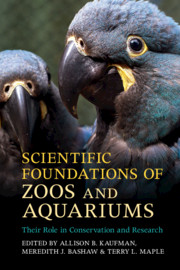Book contents
- Scientific Foundations of Zoos and Aquariums
- Scientific Foundations of Zoos and Aquariums
- Copyright page
- In Memoriam
- Epigraph
- Contents
- Contributors
- Acknowledgments
- Introduction
- Part I Programs and Initiatives
- 1 Evolving Approaches to Zoo-Based Conservation
- 2 Protecting an Underwater Rainforest
- 3 Headstarting as a Conservation Strategy for Threatened and Endangered Species
- 4 Strategic Gene Banking for Conservation
- 5 The Environmental Education Program at São Paulo Zoo (Brazil)
- 6 Conservation and Education through Dolphin Research and Eco-Tourism
- Part II Captive Care and Management
- Part III Saving Species
- Part IV Basic Research
- Conclusion
- Appendix
- Index
- References
1 - Evolving Approaches to Zoo-Based Conservation
from Part I - Programs and Initiatives
Published online by Cambridge University Press: 21 December 2018
- Scientific Foundations of Zoos and Aquariums
- Scientific Foundations of Zoos and Aquariums
- Copyright page
- In Memoriam
- Epigraph
- Contents
- Contributors
- Acknowledgments
- Introduction
- Part I Programs and Initiatives
- 1 Evolving Approaches to Zoo-Based Conservation
- 2 Protecting an Underwater Rainforest
- 3 Headstarting as a Conservation Strategy for Threatened and Endangered Species
- 4 Strategic Gene Banking for Conservation
- 5 The Environmental Education Program at São Paulo Zoo (Brazil)
- 6 Conservation and Education through Dolphin Research and Eco-Tourism
- Part II Captive Care and Management
- Part III Saving Species
- Part IV Basic Research
- Conclusion
- Appendix
- Index
- References
Summary
- Type
- Chapter
- Information
- Scientific Foundations of Zoos and AquariumsTheir Role in Conservation and Research, pp. 45 - 63Publisher: Cambridge University PressPrint publication year: 2019
References
- 1
- Cited by



